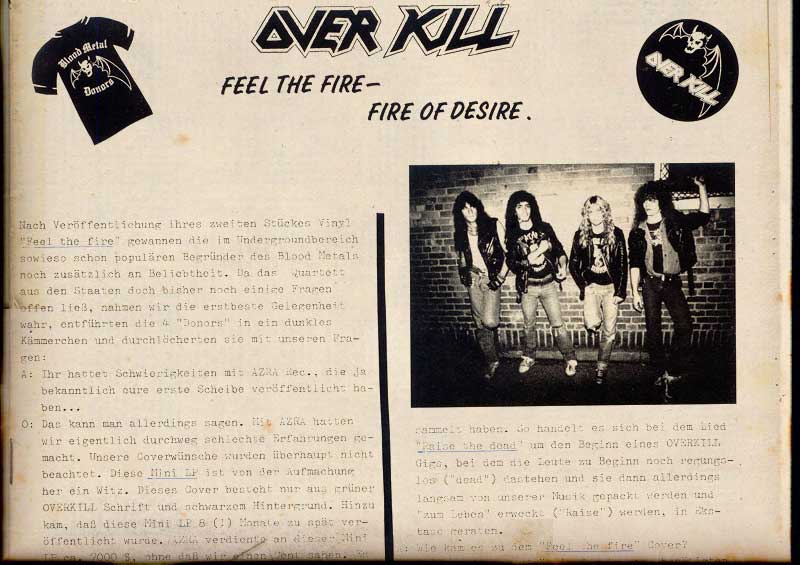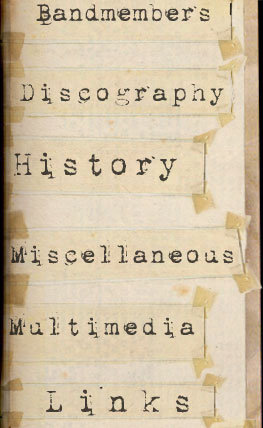 |
| •THE
INCEPTION (...OF PUNK COVER BANDS AND BLOOD METAL) |
(back
to top) |
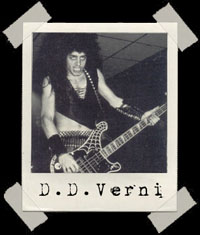 |
Overkill's
bandhistory goes back further than most would expect at
first. Even before bands like Metallica, Anthrax or Slayer
formed, Overkill members were already kicking ass and
taking names. In 1978 already, Carlo Verni (aka DD Verni)
and Lee Kundrat (aka Rat Skates) played in a punk outfit
called "The Lubricunts". The band broke up in
1980 however, with Verni and Skates trying to get a new
project off the ground. Verni set up a newspaper ad to
which Robert (Bobby) Ellsworth responded. Ellsworth, at
that time, handled bass and vocal duties in |
| his
cover band D.O.D. but wanted to concentrate solely on
singing in the new band. The frontman spot was now covered.
After several name changes (f.e. Virgin Killer) the band
- all avid Motörhead fans - simply named themselves
after their favorite Motörhead album : OVERKILL |
| In
the beginning, the band (still under the Virgin Killer
moniker) played punk covers exclusively. There were 2
guitarists (names unknown) in the band when they started
playing together in 1980, mostly doing songs from Motörhead
(Ace of spades album in particular), Iron Maiden, Judas
Priest, Riot and the like. At one point in time, a certain
Dan Spitz was also part of the game. The time as coverband
heavily influenced the style and the sound of the band,
as can be heard on the first few Overkill albums that
are chockfull of Priest- and Maiden-reminiscences. |
|
| Dan
Spitz left the band in 1981, later on to join the ranks
of Anthrax. His replacement Rich Conte, formerly active
in "The Dropouts", brought with him a guitarist
named Bobby Gustafson, who completed the twin guitar lineup. |
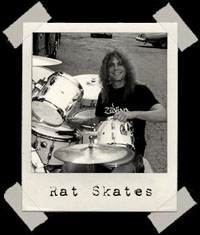 |
From
now on, the band started writing original material. Songs
like "Grave Robbers" (later to be renamed to
"Raise the dead"), "Overkill" or "Unleash
the beast within" were written during this period.
"Blood Metal", as Overkill tagged their style,
was born. Other songs like "Death Rider" (1981)
and "Rotten to the core" (1982) soon followed.
Rich Conte decided to leave the band, Gustafson however
stayed and took over all guitar duties. This lineup was
to remain stable for the next several years. The band
started to attract attention with their music and soon
played their first gigs in |
| New
York and New Jersey. Back then Bobby got his nickname
"Blitz" from DD, as Bobby could not handle the
quick success, resulting in him becoming much too euphoric
and even getting kicked out of the band for several days.
In the same period of time, the green Overkill-logo was
created. |
| The
band's logo was to be shown on a promo poster, and since
most bands had red logos Overkill decided to separate
themselves from the rest once again and had their logo
printed in green. This green logo would become an Overkill
trademark over the years. Another new part of Overkill's
concept was a band mascot - Maiden had Eddie, Helloween
a pumpkin and Overkill designed "Charly" -
a skull with batwings. |
|
|
|
|
| •
ASCENSION (DEMO, METAL MASSACRE, EP) |
(back
to top) |
Between
March and September 1983, the legendary "Power in black"
EP was recorded in two separate studio sessions. The first tapes
had been sent to local radio station and metal mags, which allowed
the band to spread their music quickly and sell over 1000 copies
worldwide. The tape was also well received in the tapetrader
underground and soon became one of the most sought-after demo
tapes, apart from being a hot topic in the scene.
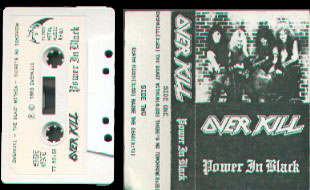 |
Seite A:
1.Overkill (3:23)
2.The Beast Within (4:05)
3.There's No Tomorrow (3:35)
Seite B:
4.Deathrider (3:50)
5.Raise The Dead (3:13) |
In
1984, hard work started paying off. "Death Rider"
was featured on the fifth issue of Brian Slagel's "Metal
Massacre" sampler, followed shorty by "Feel the fire"
on another sampler called "New York Metal 84".
The
band developed (and paid out of their pocket) their first real
stage set, introducing Bobby Blitz's black cape, in May. Overkill
stageshows became more and more complex and "bombast-laden"
which led to a rise in both the popularity of their gigs as
well as the band's performances. Their popularity rose to such
a degree that the band could be seen performing on NY and NJ
cable TV.
The
band recorded a self-titled EP from October to November 1984
in the "Venture Sound Studio" in New York, financed
by a small label (Azra/Metal Storm Records). Said label though
was so short on money that the EP's planned cover was reduced
step by step until only a green logo on a black background
remained. The release was also heavily delayed - it took the
label until July 1985 to produce and distribute 4000 copies.
Overkill never earned any money off the revenue of this record
and quickly left Azra/Metal Storm Records.
Seite
A : Rotten to the Core, Fatal if Swallowed
Seite B : The Answer, Overkill
Today
this EP, just like the "Power in black" demo, is
almost impossible to get. On eBay and Metal Markets, ludicrously
high prices are being paid for both releases - owners should
consider themselves lucky.
|
| •
SUCCESSFUL YEARS (ALBEN, TOURS, VIDEO CLIPS) |
(back
to top) |
With
the extremly successful "Power in black" demo and
"Overkill" EP, it was but a matter of time until
record labels noticed Overkill. Already a cult band in tape
trader circles, expectations for the first full-length album
were extremely high when Overkill signed their first record
deal with Megaforce Records. Recorded in the Pyramid Studios
NY, the first Overkill album came to be with producer Carl
Canedy at the helm. Entitled "Feel the fire", the
cover shows the guys in fron of a fire wall. As there was
neither money for nor interest in computer generated images
back in the 80s, the picture was actually shot with the band
standing in front of a huge wall of fire. During the shot,
the musicians had to stand extremely close to the fire - actually
close enough that some hair was burnt. In the end, though,
it was well worth the effort for a perfectly fitting cover.
|
| •
FEEL THE FIRE (1985) |
(back
to top) |
For
many fans the ultimate Overkill record. Licensed in Germany
by Noise and released in Germany in early 1986, the album started
quite a revolution musically. Overkill were just different from
most different acts - Feel The Fire has a certain original touch
and plenty of raw power. Featuring killer tracks like Rotten
To The Core", "Hammerhead", "Overkill"
and titletrack „Feel the Fire“, the weak production
barely matters.
Their
first visit to Germany was with the US Speed Metal Attack tour
along with Agent Steel and Anthrax in 1986. The Metal Hammer-Roadshow
video about that tour remains as a cult item to this day.
|
| •
TAKING OVER (1987) |
(back
to top) |
The
sophomore-effort contains even more power and speed. Starting
out with "Deny The Cross", the band churns out killer
riffs and songs by the dozen. Produced by Alex Perialas, the
guys also re-recorded "Fatal If Swallowed" off of
their classic Power in black-demo, besides continueing the
Overkill saga.. the nightmare continues. The first music video
was shot for "In Union We Stand", even though the
band originally intended to shoot a video for "Powersurge".
MTV convinced the band that "In Union We Stand"
would be the better choice and another clip could be done
in the future, however.
On
the accompanying European tour, Overkill opened for Helloween,
who were no match for the wrecking crew. A US tour supporting
Megadeth and a Japanese tour followed before Overkill returned
to Europe in 1988.
|
| •
FUCK YOU - EP (1987) |
(back
to top) |
This
EP contains songs from the first two studio efforts exclusively,
like "Electro-Violence", and features a cover that
was originally forbidden in the US. Recorded live in a Cleveland
club and without any overdubs, the band managed to ban the
raw power and intensity of an Overkill show on vinyl. As said,
the PMCR found the cover to be offensive and pressured Atlantic
Records to change the cover, delaying the release for an indefinite
amount of time. Atlantic eventually decided not to release
the record at all. Later on, a Megaforce-sublabel (Caroline
Rec.) released the EP but had to cover up the actual cover
in a black sleeve. In 1997, "Fuck You" was re-released
with a bunch of bonus tracks like the Power In Black-songs
and excellent video footage.
On
a sadder note, this EP is also the parting gift from drummer
Rat Skates and marks the first big caesura in Overkill's history.
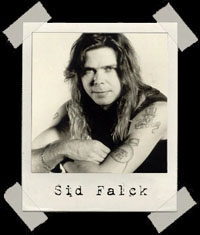 |
Rat
intended to get married, which the band was aware
of, but nobody had expected him to leave the band
because of it. Rumor has it that Rat worked as a truck
driver after his departure from Overkill, others say
he died in a bizarre gardening accident. Nobody really
knows, actually. One Mark Archibole sat behind the
kit for a number of gigs, up until the band found
a worthy replacement for Rat in Bob Falck (aka Sid
Falck). Sid changed from Paul DiAnno's Battlezone
to Overkill. Most of you should know Paul DiAnno as
the first singer (on album, anyway) for British heavy
metal legends Iron Maiden. The guys nicknamed their
new drummer
|
Sid
as there already were two Bobbys in the band. Sid
actually is an acronym for "serious insane dane",
something the band came up with when Sid started drinking
eau de cologne on a party after they had run out of
beer. Go figure. Changing the drummer also meant that
Sid had to learn all of his predecessor's parts, so
that the recording of the new album had to be delayed.
|
|
| •
UNDER THE INFLUENCE (1988) |
(back
to top) |
With
Sid Falck new in the band, this album turned out to be a tried&true
thrasher, dividing the fanbase for the first time. The songs
are partially difficult to digest and pretty brutal, the album
really shines as far as the sound is concerned. "Hello
From The Gutter" being the most stand-out and anthemic
track also featured in a music video. Overkill saga, part
three.
Supporting
the mighty Slayer, songs from all three albums were unleashed
upon audiences. Originally not intended to support Slayer
in Germany, Overkill got to replace Nuclear Assault who
bailed.
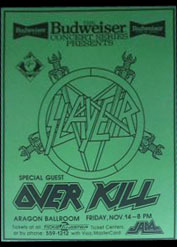
|
| •
THE YEARS OF DECAY (1989) |
(back
to top) |
In
"The Years Of Decay", the era of old Overkill should
find a worthy ending. Everything just fell into place on this
one, from Deny Date's production and the song material, to
the comic-style cover. Another very charismatic and unique
album. Every break, every chorus and every riff had their
place in tracks like "Elimination" or the semi-acoustic
title track, up to the annihilating album closer "E.vil
N.ever D.ies".
With
this effort, Overkill topped themselves and this showed in
the ever-growing fan hordes. The success of this album brought
Overkill back to Germany, this time as headliners though -
a status the band was zealous to justify. To many fans, this
tour was Overkill at their best. Bobby Gustafson had to leave
the band after this tour and once again, Overkill were left
without a guitarist.
|
| •
THE DECLINE (THE MUSCOAL DOWNFALL) |
(back
to top) |
E.vil
N.ever D.ies - maybe an irony of fate, maybe a hint, but either
way the Overkill saga came to an end when Bobby Gustafson
left the band in 1990. In it's January '91 issue, Bobby Ellsworth
was asked about Gustafson leaving the band by Rock Hard magazine.
His version of the events are as follows: Blitz married his
longtime-girlfriend after the "Years of decay"-tour
and went on honeymoon, when everything was still intact in
Overkill. Upon returning, Ellsworth was told that Gustafson
and Verni had had a pretty bad dispute and neither of them
wanted to play in the same band together anymore. There was
no way of getting the two together to talk and work everything
out, so Verni and Gustafson made Ellsworth decide who was
to stay and who was to leave. Obviously, this was one of the
hardest decisions Ellsworth (or anyone else, for that matter)
ever had to make. He chose for Verni to stay.
In
the same year, Bobby Gustafson got the opportunity to tell
his point of view and his version to Rock Hard magazine (50th
anniversary edition, article "Eye for an eye").
According to him, several animosities with Verni - mainly
of financial nature - and occassional misdemeanor in a live
situation led him to act like he did. Gustafson was the driving
creative force in the band. The one taking care of album cover
designs and writing songs mostly by himself. It is said that
Verni double-crossed Gustafson several times, and when Blitz
took Verni's side, Gustafson saw himself forced to leave Overkill.
For many fans, this was the beginning of the end. With Gustafson,
Overkill not only lost their guitarist, but also the creative
head of the band and with him the trademark sound and structure
of their songs. From then on, Overkill has been on a steady
decline from album to album, but this story will be told elsewhere.
Ultimately, one has to say that Overkill not only made metal
history, but left their mark on it from 1983 to 1989, no matter
whether you think Gustafson's departure was for the good or
the bad of the band.
E.N.D.
History
by Jochen S.O.D (The Webmaster)
English translation by Christoph Zeller
|
|
 |


